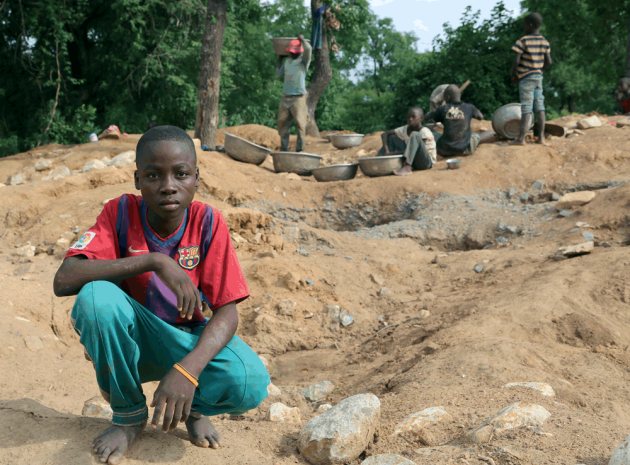Around the world, 215 million children have to work to survive. Kerry Deacon suggests how to start exploring the complex issue of child labour with your students
Today you will…
- Learn about informal gold mines and why children work there
- Discuss how working in gold mines affects children’s lives
- Develop group skills and persuasive writing skills
- Express your own opinions
Around the world, 215 million children have to work to survive. Kerry Deacon suggests how to start exploring the complex issue of child labour with your students
As secondary students up and down the country join the fun and games this Sport Relief on Friday 21st March 2014, it is important that they don’t forget why they are taking part and the difference that their fundraising can make to other people’s lives. Money raised through Sport Relief helps people living incredibly tough lives both here in the UK and across the world’s poorest countries. Some of the money raised through Sport Relief helps to fund projects that support working children to get an education, giving them a chance to build a better life for themselves and their family. In Africa, for example, one in four children aged five to 17 is a child labourer. Often child labourers have no choice but to work in difficult, hazardous conditions. This is the case in Ghana, where over 10,000 children risk their lives doing back-breaking work in informal gold mines. In this lesson your students will investigate why children in Ghana have to work and the impact this can have on the rest of their lives.
Starter activity
Display images of the objects below on the whiteboard:
- a gold ring
- a T-shirt
- a banana
- a brick.
In groups, ask the students to describe each object. Where do they think it has come from? Where do they think it has been made? Ask the groups for feedback and note down their thoughts.
Ask the whole class if they can think what all these objects might have in common. Then explain that children might have been involved at some stage in the production of each object. Millions of children around the world work on farms harvesting food like bananas and materials like cotton. Some work in mines, gathering precious metals like gold. Many others work in factories, manufacturing products such as T-shirts and bricks.
Display the words ‘child labour’ on the whiteboard. What do the students think ‘child labour’ means? What do they think might be the causes of child labour? Encourage them to consider poverty, hunger and lack of basic needs.
Extension ideas
- Drawing on their written notes from the whole class presentations, ask the students to work individually on a piece of persuasive writing to make young people aware of the issue of children working in informal gold mines in Northern Ghana.
- Encourage learners to investigate examples of working children in different parts of the world and design a poster to raise awareness of child labour.
- Ask your students to think of possible fundraising activities they could do to raise money for Sport Relief 2014.
Main activities
1 Explore the context
Play a short word association game with the students around the word ‘gold’. Note their responses on the whiteboard. Having got them thinking about gold, in small groups ask the students to discuss the following questions:
- Why do people want gold?
- How is gold used in everyday life?
- Where is gold found?
- How is gold sourced? Ask the groups to provide feedback on their answers to each question. Again, note down the students’ responses.
2 Debate and enquire
For this activity, visit sportrelief.com/secondary and show the class the slideshow of children involved in the process of informal gold mining in Northern Ghana. Read out the captions below to the students as you show them each image (if you prefer, you can search for your own images to represent the captions).
Image 1
In Northern Ghana, over 10,000 children work in informal gold mines to earn money to survive.
Image 2
Pits are dug into the earth by hand. They can be about 3 metres deep and 1 metre wide. Underground the pits are badly ventilated, poorly reinforced and at risk of collapse.
Image 3
Tools such as pick axes and shovels are used to dislodge the soil that might contain gold. Image 4 The soil is collected in bowls and brought to the surface. It is then carried to the water’s edge, where it is panned to separate the gold from the soil. Image 5 The bowls are lowered into the water and shaken from left to right. This causes the gold, which is heavy, to sink to the bottom. The soil at the top, which is lighter, is swept away.
Image 6
The remaining gold is transferred to a smaller bowl and taken to be sold. Children earn an average of five Ghanaian Cedis a day, which is the equivalent of £1.50. But if they don’t find gold, they work the entire day for nothing.
Ask your students:
- How do you feel about the images you have seen?
- How do you think it would feel to work inside the gold mines?
- How could all the physical work affect a child’s body?
- What would you expect to be paid in the UK for a full day’s work?
Divide the class into working groups and tell the students they are going to lead their own enquiry. Ask them to write a list of questions that they could use to find out more about the process of informal gold mining and why children work in gold mines. As they think about the children in the images, remind them to consider: Who, What, Why, Where and When.
You could suggest the following questions as prompts:
- Why do you think the children work?
- What impact does the income they earn have on their family?
- Do you think the work in and around the gold mine is considered harmful or hazardous? Once they have developed their questions, ask the groups to present them to the whole class.
Research and present
In their working groups again, ask the students to pick one ‘big’ question from their list. Give them time to research information to help them answer this question. They could use articles, websites and documents relating to child labour and informal gold mining in Northern Ghana.
Ask each group to prepare a five slide presentation based on their research. They need to pose their ‘big’ question and then outline the answers and conclusions from their research. Ask the students to take careful notes as they listen to each presentation and invite them to share their notes at the end.
Info bar
Get involved
For a free sport relief fundraising resource pack visit sportrelief.com/teachsecondary sport relief is an initiative of comic relief, registered charity 326568 (england/wales); sc039730 (scotland).
About the expert
Kerry Deacon is the creative learning officer, schools and youth, at Comic Relief.









Around the world, 215 million children have to work to survive. Kerry Deacon suggests how to start exploring the complex issue of child labour with your students